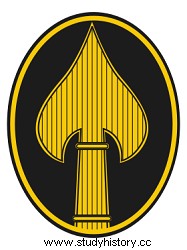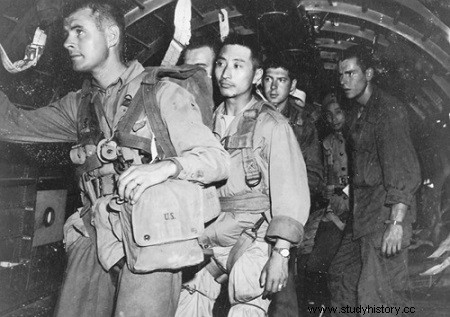
The Office of Strategic Services (OSS) was an intelligence agency of the United States government. It was created on June 13, 1942 after the United States entered World War II to collect information and conduct "clandestine" and "unordered" actions by other bodies. It was dismantled at the end of 1945 to be replaced by the CIA.

History
Since the 1930s, the FBI had been responsible for intelligence activities in Latin America, leaving the intelligence services of the US Army, the US Navy, the State Department and the Treasury their spheres of competence. and interventions.
Following the entry into the war of the United States, it was decided to reorganize intelligence. William Joseph Donovan was appointed coordinator of information and director of the OSS on July 11, 1942.
The strength of the OSS, which were mostly amateurs who learned a lot from the British intelligence services, was 13,000 in 1944.
Operations in Europe
Allen Dulles, was head of the service for Europe, under cover of a post of embassy attaché in Bern, his mailbox in France was the priest of Collonges-sous-Salève, the abbot Marius Jolivet.
During the conflict, the activities were very diverse, ranging from classical intelligence with agents like Fritz Kolbe to the sending of officers in uniform for special missions such as the Jedburghs to help the resistance in Europe occupied by the Nazis, passing by propaganda operations including Operation Corn Flakes.
In the Kingdom of Yugoslavia, the lack of coordination between the various Allied special services created serious problems. While the OSS and the Soviet services support the Yugoslav army of the homeland of Draža Mihailovic, the SOE in Yugoslavia supports the People's Liberation Army and Partisans of Yugoslavia detachments of Josip Broz Tito; these movements were quick to fight each other and the Americans withdrew while the British and Soviets agreed to support Tito.
The 2677th Regiment OSS (Prov.) created on April 15, 1944 in Algiers and incorporated on November 27, 1944 in the operational command of the OSS operates more than 50 infiltration missions in Austria, from Italy, the England (via Dijon) and also by Switzerland and Yugoslavia. Of the 76 OSS agents infiltrated in Austria, a third are made up of deserters who have volunteered, patriotic Austrians wishing to serve the cause of their country.
From June 1944, more than 200 American, Polish - 16 teams out of more than a hundred - and German anti-Nazi agents including Paul Lindner were parachuted through the Third Reich on an infiltration mission, 36 were arrested or killed but the results are estimated satisfactory.
An Anglo-American team of the OSS is dispatched during the Slovak national uprising from September 17, 1944, it was the first mission in Central Europe. These 37 members as well as officers and civilians accompanying them were killed in action or captured by the Germans, tortured and then executed.
Agents in Swiss banks helped trace Germany's financial transactions that used Nazi gold taken from occupied Europe with banks in that country, Sweden, Portugal, Turkey and Argentina. Thanks to this information, the United States government put pressure on Switzerland, which ended up symbolically reimbursing 58 million dollars to the countries thus defrauded.
On February 26, 1945, Operation Greenup was set up to obtain intelligence and information in the Innsbruck area in order to disrupt military activities.
Operations in Asia
On the Asia-Pacific front, the activities of the OSS are much less important than in Europe, because the armed forces of the United States in this theater of operations prefer to rely on their own intelligence services.
Commander Carl Eifler's Detachment 101, which collaborates with the anti-Japanese resistance movements, originally had only 21 officers to work with the ethnic Kachins who organized a force of a thousand men fighting against the imperial army Japanese.
From May 1945, teams of Detachment 101 were sent from Kunming, China to Japanese-occupied French Indochina to aid the Viet Minh movement. From New Delhi and Ceylon, other operatives oversee a network of informants and saboteurs in Burma, Malaysia and Indonesia, the most senior of which is arguably Seni Pramoj leading the Free Thai Forces.
Dismantling of the OSS
On October 1, 1945, the OSS was dismantled by President Harry Truman and its services were then distributed among various federal bodies, including:
The SSU (Special Service Unit) bringing together counterintelligence services (X-2) and secret services (Secret Intelligence Branch);
The RAB (Research &Analysis Branch) which became, 1946, the INR (Intelligence &Research), an office of the State Department responsible for collecting various political, economic and military information on all countries and for distributing the reports produced by the American diplomatic organs to all the governing bodies of the United States.
On January 22, 1946, the OSS was replaced by the CIG (Central Intelligence Group), then by the CIA (Central Intelligence Agency) despite criticism from the FBI and the armed forces, which thus lost all authority in matters of strategic intelligence. and clandestine actions.
OSS Agents
In 2008, the declassification of OSS archives by the National Archives and Records Administration revealed the names of 35,000 employees of this service.
Among the celebrities we note:
the cook Julia Child;
John Hemingway, the writer's son, who landed in Saigon in September 1945 with Lieutenant- Colonel Albert Peter Dewey;
Kermit and Quentin Roosevelt, the sons and grandsons of Theodore Roosevelt;
Arthur Schlesinger, who was the friend and historian by John F. Kennedy;
Prince Serge Obolensky;
Miles Copeland,
Stewart's father, drummer of The Police;
Arthur Goldberg, who became a Justice of the United States Supreme Court;
actor Sterling Hayden, who starred in the film The Godfather;
baseball player Moe Berg and Ralph Bunche, United Nations Under-Secretary, Nobel Peace Prize in 1950;
banker and philanthropist Paul Mellon;
director John For d,
the gangsterLucky Luciano.
Office of Strategic Services
OSS
Creation June 13, 1942
Disappearance October 1, 1945
Jurisdiction United States
Employees 13,000
Activity(ies) US Intelligence
Leadership William Joseph Donovan
